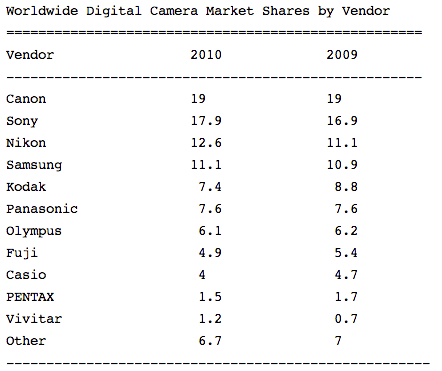With the turn of the century that came to be, there was a shift in the professional and consumer electronic world and a digital one at that. No, I’m not talking about the internet, instead, the focus this time is on the transition from film to digital. In the world of film camera, names like Nikon, Canon and Kodak ran supreme. Many of these giants have been in the camera business for over 50 years and had an established name and user group. All that however changed as companies began to shift over to this new digital revolution. Now whether it that they simply did not want to believe this shift would take place or if they had no idea how to deal with it is not the focus of this article. The fact is, with the digital revolution at hand, the camera market group was in limbo which gave way for companies like Sony who had no presence in the professional and consumer segment to enter and make a name for themselves.
Less then 10 years later, the balance has shifted completely in the DSLR and Point and Shoot market. When we consider the entire camera landscape, long time champion Canon has held a 19% market share for 2009 and 2010, while Sony has gone from 16.9% to 17.9% in the same period. Sony, now with its second place position is well ahead of Nikon which holds the 3rd place spot with 11.1% in 2009 and 12.6% in 2010. With camera sales up 10% in 2010 for a total of 141 million units sold, Sony still has a lot of room for growth, especially in the emerging markets like China and India where there might not be a lot of legacy ownership from other camera brands. With a largely untapped market and introduction of 3D digital cameras that start at just over $200, its easy to see how Sony should and will top Canon in the near future.
The story is slightly different in the DSLR market, though nearly as impressive. Canon still rules supreme with 44.5% of the market, followed by Nikon with 29.8% and Sony with 11.9%. Although the numbers indicate a much smaller market share then those of their competitors, we need to take into account that both companies, unlike Sony who has just recently (6 years) entered the DSLR market, have been in the camera business for well over 50 years have been able to not only establish their brand name and what they offer, but a loyalty among owners. Unlike other electronic segments, say a television where if you find something better, you simply replace your television set and all your existing equipment like your TiVo, Blu-ray player and receiver will continue to work with it; the camera segment has long been tied into the brand. When you choose to buy a Nikon, you have now committed to that brand, because within the camera world, the body (the actual camera) tends to be the cheapest piece of the puzzle in the long term. The real expense comes with the many different lenses that you will purchase which can and will cost in the thousands of dollars. As you continue to stock pile on these different lenses over time, even if somebody like Sony starts offer considerably better and more modern technology like their Translucent Mirror Technology, it’s hard to switch over because that means that for the most part, all of your lenses well be useless as you have to start created a new ecosystem for yourself. In 2007 Canon held a 43% DSLR market share while Nikon came in at 40% and Sony trailed in 3rd place with 6%.
Updated:
Have to thank our readers Tom and Dave for pointing out some errors in our original post.
[Via Bloomberg]


You must be logged in to post a comment.